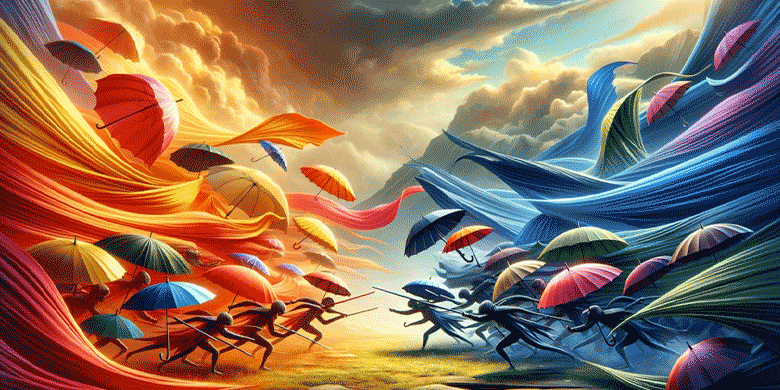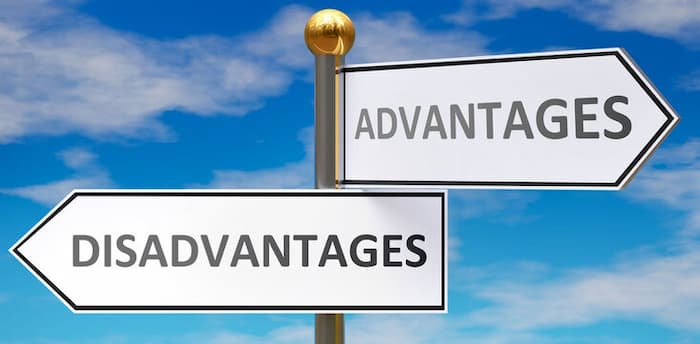
9 January, 2025
Nylon, Polyester, Pongee: Which Is The Best Umbrella Fabric
When it comes to choosing the perfect custom-printed golf umbrella, the fabric is a crucial component that often gets overlooked. In the ever-evolving world of materials, three fabrics stand out for their popularity and efficacy in umbrella manufacturing: Nylon, Polyester, and Pongee. We're going to look into the strengths and weaknesses of each, helping you make an informed choice for your next umbrella purchase.
1. Nylon: The Trailblazer
Origins and Manufacturing
Nylon was first synthesised in the 1930s by Wallace Carothers at DuPont. This revolutionary material marked the beginning of the synthetic polymer era. Originally designed as a silk substitute, nylon gained rapid popularity due to its strength and elasticity. The process of creating nylon involves the polymerisation of specific types of molecules called monomers, creating long chains of polymers. This process is known as 'melt-spinning', where the nylon polymer is melted and extruded through a spinneret to form fibres. These fibres are then cooled and stretched to enhance their strength and elasticity.
Revolution in the Umbrella Industry
With its introduction into umbrella manufacturing, nylon transformed the industry. Prior to nylon, umbrella fabrics were primarily made from cotton, silk, and other natural fibres, which were heavier and less durable. Nylon's synthetic nature offered a breakthrough with its lightweight and robust properties.

Advantages
Durability: Nylon's exceptional resilience to wear and tear is a result of its high tensile strength. This means it can withstand significant stretching and pulling without breaking, making it ideal for withstanding windy conditions.
Lightweight: The molecular structure of nylon allows it to be incredibly light without compromising on strength. This feature revolutionised umbrella designs, leading to the production of more portable and easy-to-carry options.
Drying Speed: Nylon has a low moisture absorbency rate, which contributes to its quick-drying properties. After a downpour, nylon umbrellas can be quickly shaken dry, an essential feature for people on the move.
Disadvantages
UV Sensitivity: Despite its durability, nylon's Achilles' heel is its sensitivity to ultraviolet (UV) light. Over time, exposure to sunlight can lead to the degradation of the nylon fibres, reducing their strength and altering their colour.
Environmental Concerns: It is a synthetic, petroleum-based product, which raises concerns about its environmental impact. Its production is energy-intensive, and it is not biodegradable, contributing to long-term pollution.
Water Resistance: While it is inherently water-repellent, it is not entirely waterproof. Its fibres can allow water penetration over time, especially if the umbrella is subjected to heavy rainfall. This limitation has led to the development of various coatings and treatments to enhance its water resistance.
Nylon's role in umbrella fabric is both historic and significant. Its introduction not only made umbrellas more practical and durable but also set the stage for further innovations in synthetic fabrics. While its environmental impact and UV sensitivity are notable drawbacks, ongoing research and development in the textile industry aim to address these issues, ensuring that nylon continues to be a vital material in the umbrella industry and beyond.

2. Polyester: The Popular Choice
Origins and Manufacturing
Polyester, another synthetic fabric, was developed in the early 20th century and gained widespread popularity in the 1950s. It is primarily made from ethylene, derived from petroleum. The manufacturing process of polyester involves the chemical reaction between an acid and alcohol. In this reaction, two or more molecules combine to make a large molecule whose structure repeats throughout its length. These molecules are then melted and passed through a spinneret to form long, continuous fibres. After they are cooled, they become the polyester that is used in various textiles, including umbrella fabrics.
Rise to Prominence in Umbrella Manufacturing
Polyester's rise to prominence in the umbrella industry is attributed to its versatility and cost-effectiveness. It struck a perfect balance between affordability and performance, making it a go-to choice for umbrella manufacturers around the world.
Advantages
Cost-Effective: It offers a fantastic balance between quality and affordability. This makes it an accessible material for a wide range of consumers, keeping umbrellas economical without significant sacrifices in quality or durability.
Colour Retention: Its ability to retain colour effectively over time is one of its standout features. It holds dyes well, ensuring the umbrellas stay vibrant and do not fade quickly, even under sun exposure.
Resistant to Shrinking and Wrinkling: Polyester maintains its shape and appearance over time. It is less likely to shrink compared to natural fibres and is notably resistant to wrinkles. This resilience ensures that umbrellas retain their aesthetic appeal even with regular use.
Disadvantages
Breathability: Its breathability is comparatively lower than natural fabrics. This can be a drawback in hot climates, as it can trap heat, making it uncomfortable to hold or use for extended periods.
Heat Sensitivity: The fibres can be sensitive to high temperatures. While this may not be a significant issue in everyday umbrella use, it can be a concern in extremely hot environments where the fabric might degrade or lose its integrity.
Environmental Impact: Similar to nylon, polyester is not biodegradable. Its production and disposal pose environmental challenges. It is derived from petroleum, and its manufacturing process is energy-intensive, contributing to its ecological footprint.
Polyester has firmly established itself as a dominant player in the umbrella fabric market due to its practicality and affordability. While it has some limitations in terms of breathability, heat sensitivity, and environmental impact, its strengths in cost-effectiveness, colour retention, and resistance to shrinking and wrinkling make it a highly popular choice. As with any material, ongoing innovations in fabric technology are continually enhancing the qualities of polyester, making it more sustainable and efficient for umbrella manufacturing.

3. Pongee: The Rising Star
Origins and Evolution
Pongee, originally from China, has a rich history dating back to its early use in traditional silk textiles. The term 'pongee' is derived from the Chinese word 'Pengju', referring to a high-quality silk cloth. Historically, it was made from the raw silk of silkworms and was known for its natural, unbleached colour. The traditional process of making pongee was labour-intensive, involving the careful handling of silk threads to create a smooth, fine fabric.
With advancements in textile technology, modern pongee often uses synthetic fibres, primarily polyester, to mimic the properties of silk. This transition was driven by the need for more cost-effective and durable alternatives to pure silk, while still retaining the elegant feel and appearance of the original fabric.
Advantages
Soft Texture: One of Pongee's most appealing characteristics is its soft, luxurious texture. This is a result of its fine weave and high thread count, offering a more premium feel compared to other umbrella fabrics.
Strength and Durability: Despite its delicate appearance, modern synthetic pongee is remarkably strong and durable. It stands up well against wear and tear, making it a reliable material for umbrellas, comparable in strength to nylon and polyester.
Eco-Friendlier: Modern versions made from synthetic fibres are often more environmentally friendly compared to traditional nylon or polyester. This is because newer methods of manufacturing synthetic pongee can be less resource-intensive, and advancements in textile production have focused on reducing environmental impact.
Disadvantages
Cost: Pongee, especially when made with a higher silk content, tends to be more expensive than nylon and polyester. The cost is reflective of its premium quality and the more intricate manufacturing process.
Availability: It is not as widely available as nylon or polyester. This limited availability can be attributed to its niche position in the market, where it is viewed as a more premium option.
Care Requirements: Pongee umbrellas may require more careful handling and maintenance than their nylon or polyester counterparts. While synthetic pongee is more durable than traditional silk, it still demands a degree of care to maintain its texture and appearance.
It represents an elegant and refined choice in the world of umbrella fabrics. Its rise in popularity reflects a growing demand for high-quality, eco-friendly, and aesthetically pleasing materials. While it comes with a higher price tag and may not be as readily available as other fabrics, pongee offers a unique combination of luxury, strength, and a reduced environmental footprint. For those seeking a sophisticated and durable umbrella, pongee is an excellent choice that blends tradition with modern innovation.

Conclusion: Which Is the Best?
Selecting the ideal fabric is a decision that hinges on individual preferences, environmental concerns, budget constraints, and specific usage scenarios. Nylon, Polyester, and Pongee each bring distinct qualities to the table.
Nylon: The Go-to for Durability and Lightness
Nylon, with its historical significance in the umbrella world, is synonymous with strength and lightness. If your priority is a robust umbrella that can withstand the whims of the weather, especially wind, nylon is a strong contender. Its high tensile strength means it's less likely to tear or rip in adverse conditions. However, for those concerned about environmental impact, nylon's synthetic, non-biodegradable nature could be a drawback.
Additionally, for frequent users in sunnier Australian regions like Queensland or Western Australia, the UV sensitivity of nylon might lead to quicker degradation, reducing the lifespan of the umbrella.
Polyester: The Economical Everyday Choice
Polyester umbrellas strike a fine balance between affordability and functionality. They're widely available and come in a plethora of designs, owing to the fabric's excellent colour retention. This makes it a great choice for those who value aesthetic variety and cost-effectiveness. However, it might not be the best option in extremely hot climates due to its lower breathability and heat sensitivity.
In terms of environmental concerns, like nylon, polyester is not biodegradable, which could be a consideration for eco-conscious buyers. However, its durability means it doesn't need to be replaced as often, which could be viewed as a form of resource conservation.
Pongee: The Premium, Eco-Friendlier Alternative
Pongee is emerging as a luxurious, eco-friendly alternative to traditional umbrella fabrics. Its soft texture and strength make it ideal for those who don’t mind investing a bit more for a higher-quality product. Additionally, its environmental footprint is generally smaller compared to nylon and polyester, appealing to the environmentally conscious user.
In Australian regions with more variable weather, such as Victoria or Tasmania, pongee's blend of durability and aesthetic appeal can be particularly attractive. However, its higher cost and care requirements might be a drawback for some users.
The Verdict: Tailored to Your Needs
In sum, the decision comes down to what you value most in an umbrella:
Nylon: Opt for nylon if you prioritise longevity and lightness and aren’t overly concerned about UV sensitivity or environmental factors.
Polyester: Choose polyester for an affordable, colourful, and versatile option, especially suitable for everyday use.
Pongee: Select Pongee if you prefer a more luxurious feel and eco-friendliness and are willing to invest more for premium quality.
Remember, in a country like Australia, with its diverse climate ranging from the tropical north to the cooler southern states, the ideal fabric may also be influenced by your local weather conditions. Ultimately, the best choice is one that aligns with your personal needs, lifestyle, and values, ensuring that your umbrella is a companion you can rely on, come rain or shine.
The Umbrellas Only Team
